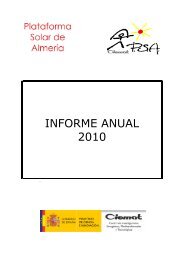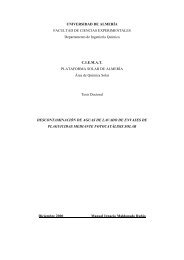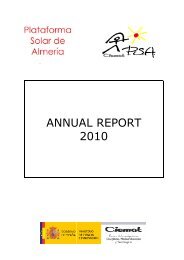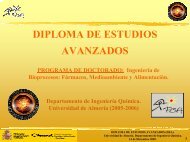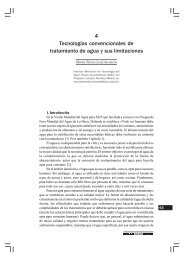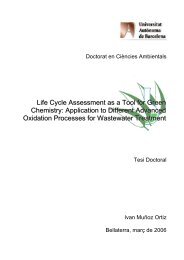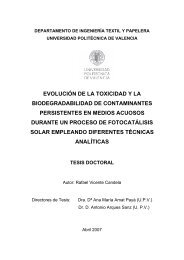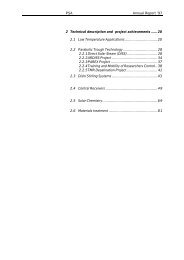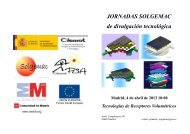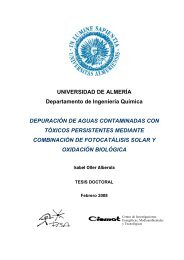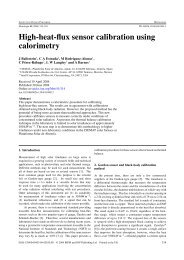Annual Report 2006 - Plataforma Solar de AlmerÃa
Annual Report 2006 - Plataforma Solar de AlmerÃa
Annual Report 2006 - Plataforma Solar de AlmerÃa
Create successful ePaper yourself
Turn your PDF publications into a flip-book with our unique Google optimized e-Paper software.
PLATAFORMA SOLAR DE ALMERÍA<br />
a<strong>de</strong>quate for coating sensitive substrates. In addition stabilized suspensions<br />
of commercial pow<strong>de</strong>red TiO 2 will be also used for comparison. Dip-coating<br />
and an innovative electrospray <strong>de</strong>position technique will be utilized for photocatalysts<br />
preparation. Photocatalytic activity and catalyst stability with each of<br />
the different preparation variables will be studied for the <strong>de</strong>gradation of three<br />
representative organic pollutants: trichloroethylene, toluene and formic acid.<br />
Achievements in <strong>2006</strong>: CIEMAT activity during this period was mainly focused<br />
on the synthesis of TiO 2 -coated materials of different porosity and transparency:<br />
non-porous transparent supports, like borosilicate glass and organic<br />
polymers (PET, cellulose acetate), and opaque ceramic substrates (natural<br />
magnesium silicate plates calcined at different temperatures, which were prepared<br />
in the ICP-CSIC), which present mesoporosity.<br />
100<br />
Conversion, %<br />
90<br />
80<br />
70<br />
60<br />
50<br />
3TiO 2 _G5_Sep800ºC<br />
TiO 2 50_Sep50_500ºC<br />
3TiO 2 _G5_porta350ºC<br />
0 2 4 6 8 10<br />
Area/F, s/cm<br />
Figure 4.12<br />
Trichloroethylene conversion as a function of the<br />
illuminated area to flow ratio (Area/F) for three<br />
different photocatalyts: TiO 2 coating on the silcate, a<br />
50:50 W/w TiO 2 /silicate mixture and a TiO 2 layer on<br />
a glass plate. Initial pollutant concentration 10 ppmv<br />
An example of the of the efficiency of the obtained materials is shown in<br />
Figure 4.12, which compare the performance of the same TiO 2 <strong>de</strong>posited as<br />
layer on a porous ceramic or on a <strong>de</strong>nse glass plate, with a bulk photocatalyst<br />
formed by a mixture of TiO 2 and silicate. These results reveal that porosity is<br />
beneficial for the TCE <strong>de</strong>gradation but the TiO 2 coating is more efficient, very<br />
likely due to a better exposure to the light. On the other hand, TiO 2 sol-gel<br />
<strong>de</strong>posited on transparent supports, like those shown in Figure 4.11, have also<br />
proved to be very efficient for VOC abatement. Nevertheless, polymeric supports<br />
may suffer radiation damage and several strategies to increase their<br />
durability have been tested, including the formation of a SiO 2 protective barrier<br />
layer.<br />
4.3.2 (DETOX-H2S)<br />
Development of a new system for the elimination of air<br />
borne toxic and corrosive compounds generated in sewage<br />
treatment plants<br />
Participants: CIEMAT, ICP-CSIC, ICV-CSIC and UNED (Spain); USACH (Chile)<br />
and Univ. of Wisconsin (USA).<br />
Contact:<br />
Dr. B. Sánchez; benigno.sanchez@ciemat.es<br />
Funding: CAM fun<strong>de</strong>d project, cost shared: 700 k€<br />
86



